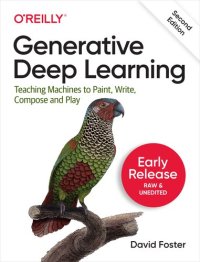
Ebook: Generative Deep Learning: Teaching Machines to Paint, Write, Compose, and Play, 2nd Edition (Seventh Early Release)
Author: David Foster
- Genre: Computers // Algorithms and Data Structures: Pattern Recognition
- Year: 2022
- Publisher: O'Reilly Media
- Edition: 7
- Language: English
- epub
Generative modeling is one of the hottest topics in AI. It's now possible to teach a machine to excel at human endeavors such as painting, writing, and composing music. With this practical book, machine learning engineers and data scientists will discover how to re-create some of the most impressive examples of generative deep learning models such as variational autoencoders (VAEs), generative adversarial networks (GANs), Transformers, normalizing flows, energy based models, and diffusion models.
Author David Foster demonstrates the inner workings of each technique, starting with the basics of deep learning before advancing to some of the most cutting-edge algorithms in the field. Through tips and tricks, you'll understand how to make your models learn more efficiently and become more creative.
A generative model can be broadly defined as follows:
Generative modeling is a branch of Machine Learning (ML) that deals with the creation of models that can generate new data points that are similar to the training data.
What does this mean in practice? Suppose we have a dataset containing images of horses. We may wish to build a model that can generate a new image of a horse that has never existed but still looks real because the model has learned the general rules that govern the appearance of a horse. This is the kind of problem that can be solved using generative modeling.
In order to truly understand what generative modeling aims to achieve and why this is important, it is useful to compare it to its counterpart, discriminative modeling. If you have studied Machine Learning, most problems you will have faced will have most likely been discriminative in nature.
The Chapter 3 will first lay out the theoretical underpinning of generative adversarial networks (GANs). You will then learn how to build your own GANs using Keras. We use the Keras function image_dataset_from_directory to create a Tensorflow Dataset pointed at the directly where the images are stored. This allows us to read batches of images into memory only when required (e.g. during training), so that we can work with large datasets and not worry about having to fit the entire dataset into memory.
Discover how VAEs can change facial expressions in photos
Build practical GAN examples from scratch to generate images based on your own dataset
Create autoregressive generative models, such as LSTMs for text generation and PixelCNN models for image generation
Build music generation models, using Transformers and MuseGAN
Explore the inner workings of state-of-the-art architectures such as StyleGANGPT-3, and DDIM
Dive into the the detail of multimodal models such as DALL.E 2 and Imagen for text-to-image generation
Understand how generative world models can help agents accomplish tasks within a reinforcement learning setting
Understand how the future of generative modeling might evolve, including how businesses will need to adapt to take advantage of the new technologies
Author David Foster demonstrates the inner workings of each technique, starting with the basics of deep learning before advancing to some of the most cutting-edge algorithms in the field. Through tips and tricks, you'll understand how to make your models learn more efficiently and become more creative.
A generative model can be broadly defined as follows:
Generative modeling is a branch of Machine Learning (ML) that deals with the creation of models that can generate new data points that are similar to the training data.
What does this mean in practice? Suppose we have a dataset containing images of horses. We may wish to build a model that can generate a new image of a horse that has never existed but still looks real because the model has learned the general rules that govern the appearance of a horse. This is the kind of problem that can be solved using generative modeling.
In order to truly understand what generative modeling aims to achieve and why this is important, it is useful to compare it to its counterpart, discriminative modeling. If you have studied Machine Learning, most problems you will have faced will have most likely been discriminative in nature.
The Chapter 3 will first lay out the theoretical underpinning of generative adversarial networks (GANs). You will then learn how to build your own GANs using Keras. We use the Keras function image_dataset_from_directory to create a Tensorflow Dataset pointed at the directly where the images are stored. This allows us to read batches of images into memory only when required (e.g. during training), so that we can work with large datasets and not worry about having to fit the entire dataset into memory.
Discover how VAEs can change facial expressions in photos
Build practical GAN examples from scratch to generate images based on your own dataset
Create autoregressive generative models, such as LSTMs for text generation and PixelCNN models for image generation
Build music generation models, using Transformers and MuseGAN
Explore the inner workings of state-of-the-art architectures such as StyleGANGPT-3, and DDIM
Dive into the the detail of multimodal models such as DALL.E 2 and Imagen for text-to-image generation
Understand how generative world models can help agents accomplish tasks within a reinforcement learning setting
Understand how the future of generative modeling might evolve, including how businesses will need to adapt to take advantage of the new technologies
Download the book Generative Deep Learning: Teaching Machines to Paint, Write, Compose, and Play, 2nd Edition (Seventh Early Release) for free or read online
Continue reading on any device:

Last viewed books
Related books
{related-news}
Comments (0)